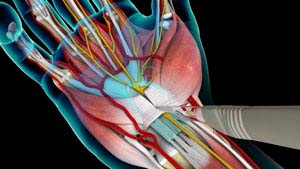Carpal Tunnel Release Surgery

Carpal Tunnel Syndrome is a common, painful, progressive condition that is caused by compression of the median nerve at the wrist area. Carpal tunnel syndrome may be treated using conservative approaches or surgery. Surgical treatment of carpal tunnel syndrome is called carpal tunnel release surgery.
Traditional surgery involves up to a 2- inch incision in the palm and wrist area, whereas endoscopic surgery involves one or two half-an-inch incisions and the use of an endoscope. During the surgery, the transverse carpal ligament will be dissected to release the pressure on the median nerve and enlarge the carpal tunnel. Your surgeon will decide which options are best for you based on your general and medical conditions.
Post-Operative Care
Your surgeon may suggest you practice certain post-operative procedures for better recovery and to avoid further complications.
- Elevate the hand above heart level to reduce swelling.
- A splint may be worn
- Ice packs to the surgical area to reduce swelling.
- Keep the surgical incision clean and dry. Cover the area with plastic wrap when bathing or showering.
- Physical therapy may be ordered to restore wrist strength.
- Eating a healthy diet and not smoking will promote healing
Risks and Complications
Most patients suffer no complications following carpal tunnel release surgery. However, some patients may suffer from pain, infections, scarring, and nerve damage causing weakness, paralysis, or loss of sensation and stiffness in the hand and wrist area.
